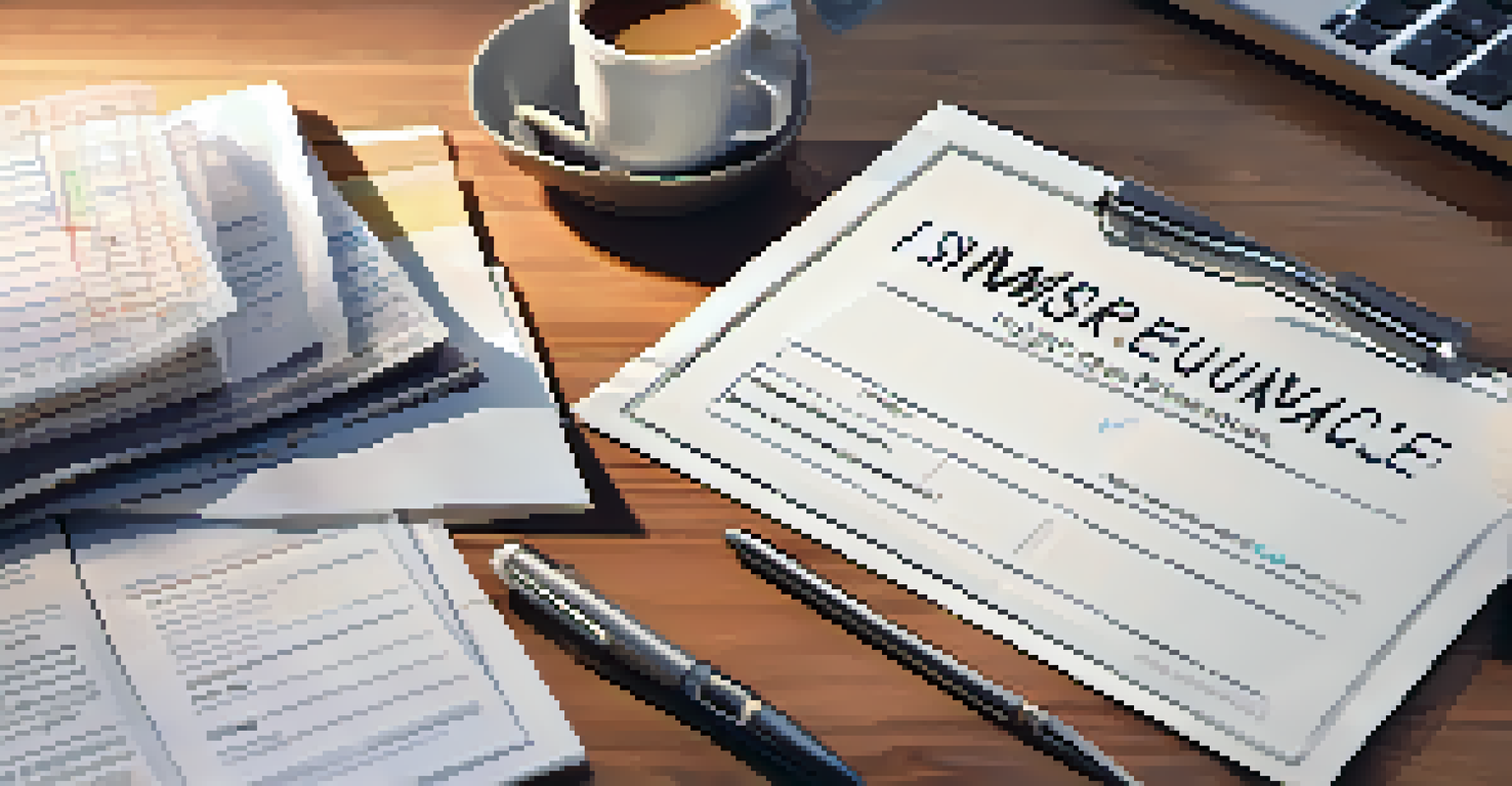How to Read and Understand Your Home Insurance Policy

Understanding the Basics of Home Insurance Policies
Home insurance policies are designed to protect your property from various risks. These risks can include natural disasters, theft, and liability claims. Understanding the basics helps you grasp what is covered and what isn’t, so you can make informed decisions.
Insurance is a safety net. It’s there to catch you when life throws you a curveball.
Typically, a home insurance policy provides coverage for your dwelling, personal belongings, and liability. Each of these components plays a crucial role in protecting your home and finances. By familiarizing yourself with these terms, you can better navigate your policy.
Think of your home insurance as a safety net. Just as you wouldn’t walk a tightrope without a safety harness, you shouldn’t own a home without adequate insurance. Knowing the basics is the first step in ensuring you’re well-protected.
Breaking Down the Key Terms in Your Policy
Insurance policies are filled with terminology that can feel like a foreign language. Terms like 'deductible', 'premium', and 'exclusions' are common but often misunderstood. Taking the time to break down these terms will help you understand your coverage better.

For example, a 'deductible' is the amount you'll pay out of pocket before your insurance kicks in. The 'premium' is the monthly or annual payment you make to maintain your coverage. Knowing these terms will help you manage your policy effectively.
Know Your Home Insurance Basics
Understanding the key components of home insurance can help you make informed decisions about your coverage.
Consider this: reading your home insurance policy is like learning to read a map. Each term is a landmark that guides you through your coverage. By understanding each term, you’ll feel more confident navigating your policy.
Identifying What Your Policy Covers
Every home insurance policy varies in coverage, so it’s essential to identify what is included. Most policies cover damage to your home, personal property, and liability for injuries on your property. However, specific events might require additional coverage.
The best time to prepare for a disaster is before it happens.
For instance, standard policies often don’t cover natural disasters like floods or earthquakes. If you live in an area prone to these events, you may need to purchase separate policies. Knowing what’s covered can help you avoid unpleasant surprises when you need to file a claim.
Think of your policy coverage as a buffet. You want to choose the right dishes (or coverage) that suit your needs. By clearly understanding what’s included, you can ensure your home is fully protected.
Understanding Exclusions in Your Policy
Exclusions are specific situations or items that a home insurance policy does not cover. It’s crucial to read this section carefully to avoid confusion later on. Knowing what isn’t covered can help you take preventive measures.
Common exclusions include wear and tear, maintenance issues, and certain natural disasters. For example, if a tree falls on your home during a storm, it may be covered, but if it falls due to decay, it likely won’t be. Understanding these exclusions can help you identify potential risks.
Understand Policy Exclusions
Being aware of what your policy does not cover is crucial for effective risk management and protection.
Think of exclusions as warning signs on a road. They inform you of potential hazards and help you navigate safely. By being aware of what’s not covered, you can take proactive steps to protect your home.
The Importance of Deductibles and Premiums
Deductibles and premiums play a significant role in your home insurance policy. The deductible is the amount you pay out of pocket before your insurance coverage kicks in, while the premium is the cost of maintaining your policy. Balancing these two elements is key to managing your insurance effectively.
A higher deductible usually means a lower premium, and vice versa. Understanding your financial situation can help you choose the right balance for your needs. For instance, if you can afford a higher deductible, you may save money on monthly premiums.
Imagine deductibles and premiums as a see-saw. Finding the right balance ensures your coverage is both affordable and effective. By understanding how they work together, you can make smarter financial choices.
Reviewing Your Policy Annually
Your home insurance needs may change over time, which is why reviewing your policy annually is essential. This review allows you to adjust coverage based on upgrades, renovations, or changes in your personal circumstances. Staying proactive can ensure you’re adequately protected.
For example, if you’ve added a home office or purchased valuable items, you may need to increase your coverage limits. Conversely, if your home’s value has decreased, you might consider adjusting your policy accordingly. Regular reviews help you stay on top of your coverage.
Review Your Policy Regularly
Annual reviews of your home insurance policy ensure that your coverage meets your current needs and circumstances.
Think of this annual review as a health check-up for your insurance. Just as you’d consult a doctor to ensure your well-being, reviewing your policy ensures your coverage aligns with your current needs.
Knowing When to Seek Professional Help
Sometimes, deciphering your home insurance policy can feel overwhelming, and that’s perfectly okay. Seeking professional help from an insurance agent or an advisor can provide clarity and guidance tailored to your situation. They can help you understand complex terms and ensure you have the right coverage.
If you’re unsure about your policy’s exclusions, deductibles, or overall coverage, don’t hesitate to reach out for assistance. An expert can provide insights that empower you to make informed decisions. Remember, it’s better to ask questions than to risk being underinsured.

Think of an insurance agent as a knowledgeable friend who understands the ins and outs of insurance. Just as you’d consult a friend for advice, seeking professional help can make navigating your policy much easier.